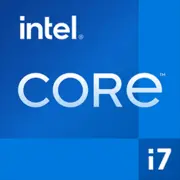Intel Core i7-12700K

インテル Core i7-12700K: 2025年プロセッサの包括的なレビュー
2025年4月
はじめに
インテル Core i7-12700Kは、2021年末に発売され、4年経った今でもエンスージアストたちにとって強力な選択肢であり続けています。Alder Lakeのハイブリッドアーキテクチャと新しい標準のサポートにより、現代のモデルと競争し続けています。本記事では、なぜこのCPUが今でも需要があるのか、2025年にどのような人々に適しているのかを説明します。
1. 主な仕様:アーキテクチャとパフォーマンス
ハイブリッドアーキテクチャ Alder Lake
i7-12700Kは、インテルのハイブリッドアーキテクチャを採用した初期のプロセッサの1つで、8つのパフォーマンスコア(P-Core)と4つのエネルギー効率コア(E-Core)を備えており、合計で12コアと20スレッドを持ちます。P-Coreは重いタスク(ゲームやレンダリング)を担当し、E-Coreはバックグラウンドプロセスの負荷を軽減します。
インテル 7プロセス
名称に反して、プロセスは10nm Enhanced SuperFinに対応しています。これにより、消費電力を抑えつつクロック周波数を向上させることができました。P-Coreの基本クロックは3.6GHz、ターボブースト時には4.9GHzまで達します。
主な特徴
- 25MBのL3キャッシュ:メモリ操作時のレイテンシを減少させます。
- PCIe 5.0とDDR5のサポート:将来に備えたアップグレード解決策。
- インテル UHD グラフィックス 770:オフィス作業や緊急時のための内蔵グラフィックス。
ベンチマークテストでのパフォーマンス
- Geekbench 6:2519(シングルコア)、13634(マルチコア)。
- ゲームで(例:サイバーパンク2077)、CPUはRTX 4070 Tiとの組み合わせで安定して120+ FPSを示します。
- Blenderでのレンダリングでは、BMWシーンのレンダリング時間は約4.5分です。
2. 対応マザーボード
LGA 1700ソケット
このプロセッサはLGA 1700ソケットのマザーボードを必要とします。2025年までにほとんどのモデルはAlder Lakeとの互換性のためにBIOSの更新を受けています。
チップセット
- Z690/Z790:オーバークロックに最適な選択肢(XMP 3.0、PCIe 5.0に対応)。例:ASUS ROG Strix Z790-E Gaming(350〜400ドル)。
- B660/B760:基本機能の予算向けマザーボード(オーバークロック不可)。例:MSI B760 Tomahawk WiFi(180〜220ドル)。
- H610:オフィス用途向け(PCIe 5.0なし、制限されたメモリサポート)。
選択のポイント
- 新しいメモリを使用する予定がある場合は、ボードがDDR5をサポートしていることを確認してください。
- オーバークロックを行う場合は、VRMが12+1フェーズ以上のモデルが必須です。
3. サポートメモリ:DDR4 vs DDR5
DDR4
- 長所:低価格(約60ドルで32GBの3600MHz)、古い構成との互換性。
- 短所:限られた帯域幅。
DDR5
- 長所:最大6400MHzの速度(2025年には32GBが100〜150ドルで入手可能)。
- 短所:高いレイテンシ(CAS 40+)、ただし2025年には最適化されています。
推奨
ゲーム用には:DDR5-6000の遅延の少ないモジュール。作業用には:64GBのDDR4。
4. 電源ユニット:出力計算
エネルギー消費
- TDPは125Wですが、オーバークロック時には消費が190〜200Wに達します。
- RTX 4080を搭載したシステムは負荷時に600Wまで引き上げます。
推奨
- 最低:650W(例:Corsair RM650x、110ドル)。
- オーバークロック用:750〜850Wの80 Plus Gold認証(Seasonic Focus GX-850、140ドル)。
5. 利点と欠点
利点
- ゲーム用の高いシングルコアパフォーマンス。
- DDR5とPCIe 5.0のサポート。
- ハイブリッドアーキテクチャがマルチスレッド性能を向上させます。
欠点
- 高い熱出力:冷却システムまたは高性能クーラーが必要です。
- 価格:2025年でも新しいi7-12700Kは約300ドル(Ryzen 7 7700Xより20%安い)です。
6. 使用シナリオ
ゲーム
- 1440pや4Kに最適。Call of Duty: Warzone 3ではDDR5と組み合わせて160+ FPSを達成します。
作業タスク
- DaVinci Resolveでの動画編集:4Kプロジェクトのレンダリングに12〜15分。
- 3Dモデリング:AutoCADやSolidWorksでの安定した動作。
マルチメディア
- E-coreによるFPSの損失なしでのストリーミング。
7. 競合製品との比較
AMD Ryzen 7 7700X
- 価格:320ドル(新品)。
- 長所:優れたエネルギー効率、2026年までのAM5サポート。
- 短所:シングルコアテストで劣る(Geekbench 6シングルコア:2400)。
インテル Core i5-14600K
- 価格:280ドル。
- 長所:安価でP-Coreのクロックが高い(5.3GHz)。
- 短所:14スレッドのみ、キャッシュが少なめ。
8. 組み立ての実用的なヒント
- 冷却:AIO冷却(例:Arctic Liquid Freezer II 280、90ドル)やタワークーラー(Noctua NH-D15、100ドル)を選ぶ。
- ケース:良好な換気が必須(Lian Li Lancool III、150ドル)。
- BIOSの更新:古いZ690マザーボードには更新が必要な場合があります。
9. 最終的な結論:i7-12700Kは誰に適しているか?
次のような方にこのプロセッサを選ぶことをお勧めします:
- AAAゲームで最高のFPSを追求するゲーマー。
- レンダリングや編集作業を行う専門家。
- CPUの変更なしにDDR5にシステムをアップグレードしたいエンスージアスト。
2025年においても、i7-12700Kは価格とパフォーマンスのバランスを求める人々にとって魅力的な選択肢です。そのハイブリッドアーキテクチャと新しい標準への対応は、数年間の関連性を保証します。
基本
CPUの仕様
メモリ仕様
GPUの仕様
その他
ベンチマーク
他のCPUとの比較
ソーシャルメディアで共有する
または当サイトへのリンクを追加
<a href="https://cputronic.com/ja/cpu/intel-core-i7-12700k" target="_blank">Intel Core i7-12700K</a>